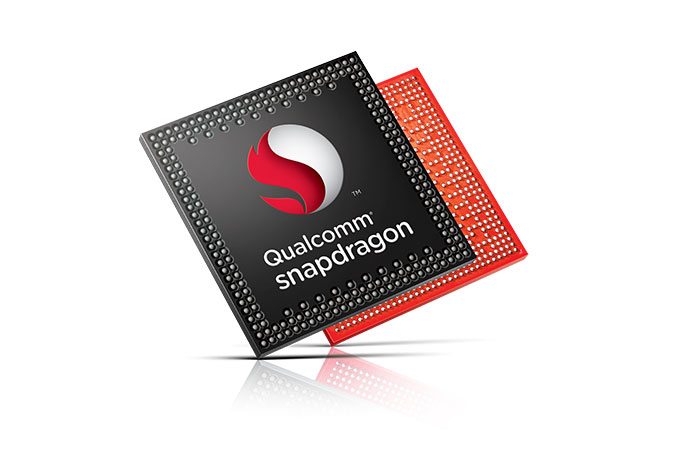Qualcomm's Snapdragon 801 (MSM8974AC): The New 32-bit Flagship Until 805
by Anand Lal Shimpi on February 24, 2014 2:00 AM EST- Posted in
- SoCs
- Qualcomm
- Snapdragon 801

As Qualcomm continues to move its SoCs to 64-bit ARMv8 based cores, there's still demand for high-performance 32-bit solutions today. We're still some months away from Snapdragon 805 showing up in devices, but the next generation of Android flagships is getting ready for announcement at MWC this week. To satiate the needs of its high end customers, Qualcomm is shipping a higher clocked variant of the MSM8974/Snapdragon 800 called the Snapdragon 801 (MSM8974AC).
Architecturally the SoC is identical to its namesake. The Snapdragon 801 features four 32-bit Qualcomm designed Krait 400 cores and an Adreno 330 GPU. The DSP and ISP blocks haven't changed either. And we're still talking about a 2 x 32-bit LPDDR3 memory interface. What is different are the frequencies all of these blocks operate at. The differences are in the table below:
| Qualcomm Snapdragon 800 vs. 801 | |||||
| MSM8974 (Snapdragon 800) | MSM8974AB (Snapdragon 800) | MSM8974AC (Snapdragon 801) | |||
| CPU | 4 x Krait 400 | 4 x Krait 400 | 4 x Krait 400 | ||
| Max CPU Frequency | 2.3GHz (2.26GHz) | 2.3GHz (2.26GHz) | 2.5GHz (2.45GHz) | ||
| GPU | Adreno 330 | Adreno 330 | Adreno 330 | ||
| Max GPU Frequency | 450MHz | 550MHz | 578MHz | ||
| ISP Frequency | 320MHz | 465MHz | 465MHz | ||
| Memory Interface | 2 x 32-bit LPDDR3-1600 | 2 x 32-bit LPDDR3-1866 | 2 x 32-bit LPDDR3-1866 | ||
| eMMC Interface | 4.5 | 4.5 | 5.0 | ||
| Modem | 9x25 IP block, Category 4 LTE | 9x25 IP block, Category 4 LTE, DS-DA | 9x25 IP block, Category 4 LTE, DS-DA | ||
Max CPU frequencies go up by around 8%. I put Qualcomm's official numbers in parantheses next to the numbers that are usually quoted for these parts in marketing materials. Max GPU frequency goes up by a substantial 28%, and the peak theoretical memory bandwidth goes up by 16%. Given that most mobile GPU benchmarks tend to be shader rather than memory bandwidth bound, Snapdragon 801 should do quite well in the usual metrics.
Moving to eMMC 5.0 enables support for up to a 400MB/s interface, which we'll see used by new eMMC solutions like the latest iNAND Extreme from SanDisk. The Snapdragon 801 retains a similar MDM9x25 derived modem IP block with support for Category 4 LTE, while adding support for DS-DA (dual-sim, dual-active).
You should expect to see the Snapdragon 801 used many of the major flagship smartphones announced at MWC this week.










13 Comments
View All Comments
Drumsticks - Monday, February 24, 2014 - link
You have a very tiny typo!"Qualcomm is shipping a higher clocked variant of the MSM8974/Snapdragon 800 called the Snapdragon 801 (MSM8794AC)"
I believe it should read 8974AC, not 8794AC :)
This makes more sense. It would have seemed weird for the 805 to be out just yet (I don't think it is anywhere?) but the 800 has already been around for a while. This could show up in the S5, perhaps?
Laxaa - Monday, February 24, 2014 - link
Is the power draw the same as the 800?r3loaded - Monday, February 24, 2014 - link
Close enough to be negligible.jerrylzy - Monday, February 24, 2014 - link
8974AB and 8974AC are called 8974Pro in source codes (normal s800s are called 8974v2), and the 8974Pro series have two versions: 8974Pro rev0 and 8974ProC rev1. The latter one has 16 PVS binnings with 0.1v difference between each binning's max cpu freq while the former one has 8 binnings with 0.25v difference between each binning's max cpu freq. Also all shipped 8974ABs' GPU max freq is 578mhz instead of 550mhz. I think the snapdragon 801 represents the revised 8974Pro series.darkich - Tuesday, February 25, 2014 - link
Wow..you work for Qualcomm, admit it!jerrylzy - Tuesday, February 25, 2014 - link
I don't work for Qualcomm. Everyone can see those things in N9005 KitKat kernel source codes.GNUminex - Monday, February 24, 2014 - link
The last sentence is missing a word. Also I'm curious, how long has qualcomm been using the same cpu architecture and bumbing its clocks for now?HardwareDufus - Monday, February 24, 2014 - link
801 looks good. the DS-DA is very important. I live in the Sonora Desert... as in Sonora, Mexico and Arizona, USA. I conduct business in both countries, therefore have two pone numbers. I'm always doing the SIM swapping thing at the Nogales SON/AZ border crossing.Having both chips in the same phone would be glorious! No missed calls either (roaming chargers are worth it as I'd rather not miss a call!).
Adopting the EmmC 5.0 interface is good as well.
Nokia has announced that the 1520 will be available with 32GB of Storage son (plus the microSD). I wonder if they've been waiting for the new interface to make that change? Will we see the 801/805 in an upcoming rework of the 1520?
Dual Simm capable phone 1520 would be incredible. Microsoft is going to be supporting Dual Simm capability with Windows Phone 8.1 soon.
Right now enjoying life with the 920.. The S4 (performance wise between the 400 and 600) is a decent performer.
fokka - Monday, February 24, 2014 - link
it's "SIM"tigger2u - Tuesday, February 25, 2014 - link
As homonyms, the acronyms are SIMilar. :-)